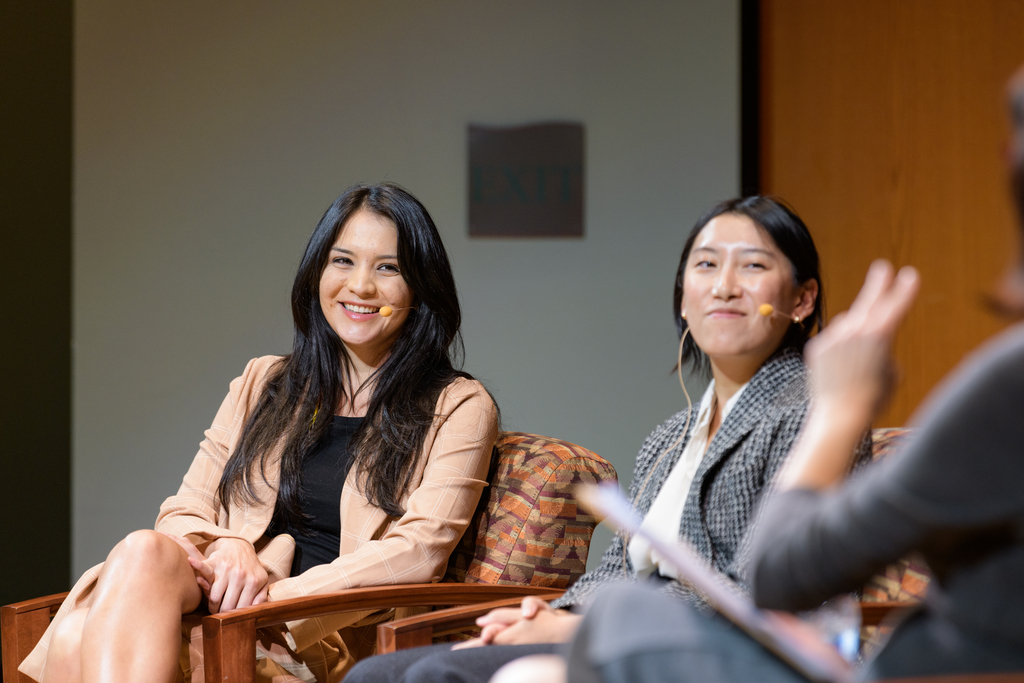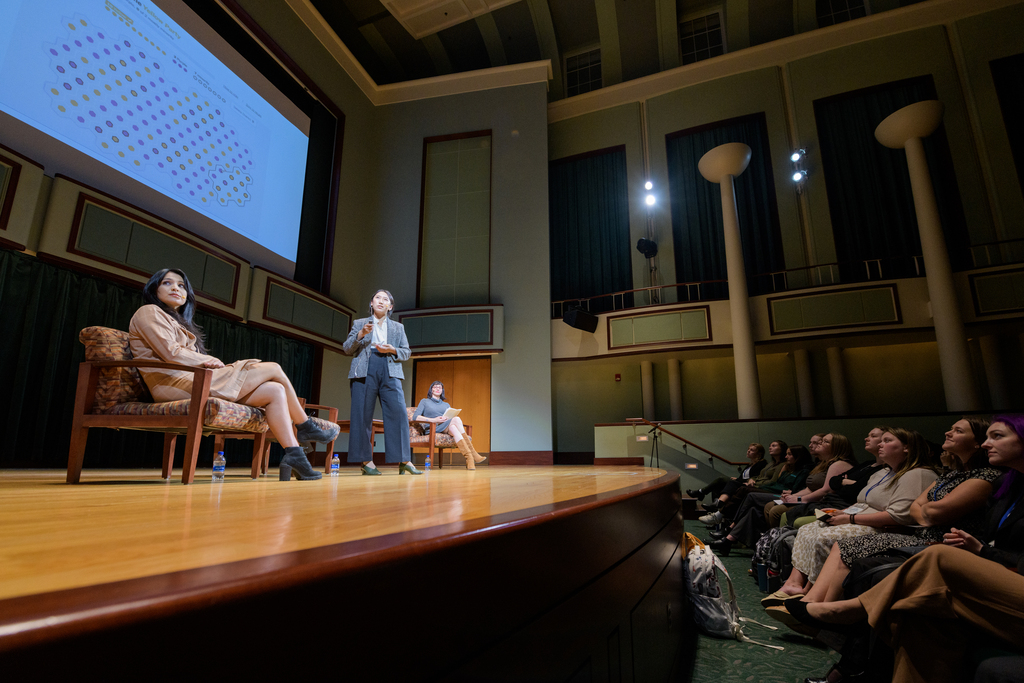Revisualizing journalism
Journalists use data and imagery to bring attention to social and political stories

Watch a video of the complete program. Read the transcript .
NEWARK, Del. – Denise Lu and Tailyr Irvine spend a lot of time thinking about numbers and how they factor into people’s lives. Lu, a New York Times graphics editor, translates raw data into engaging visual graphics that reveal complex patterns and trends about people. Irvine, a Salish and Kootenai photographer and documentarian, uses her medium to help people see beyond the stereotypes about Native Americans.
The journalists presented their work on September 28 for the University of Delaware’s twelfth annual National Agenda speaker series. They joined series director Lindsay Hoffman, Ph.D., on stage at Gore Recital Hall for a conversation about “Balancing Art and Politics.”
“The job is more or less to make visuals like charts and maps, and make sure that they tell a story to the audience,” said Lu, a Pulitzer Prize finalist who earned her journalism degree from Northwestern University. “Because I am a journalist and that is the point of what we”re trying to do with these visuals.”
Interactive digital graphics lend a fresh perspective on mundane topics such as political practice of redistricting, ‘something that most people either take for granted or don’t know about or just don’t really understand.” Lu and her team designed an interactive puzzle that put the readers “in the shoes of a politician who is trying to redistrict this fake state that we created with fake political parties.”

Readers were surprised at how easy it was to gerrymander districts to favor one party or demographic. “It was cool for us to get the feedback from readers saying that it was an enlightening exercise for them to go through this and learn about the rules of redistricting, and how it actually impacts the voters in those places,” said Lu.
Irvine grew up in northwestern Montana and graduated from the University of Montana with a bachelor’s degree in journalism with an emphasis in Native American Studies. She worked in newsrooms across the country before beginning her career as an independent journalist and documentary photographer.
Irvine said she is bringing attention to the complexities of Native American identity beyond the blood quantum fraction. Currently, Native Americans who are enrolled in a federally recognized tribe are issued a Certificate of Degree of Indian Blood (CDIB) by the Bureau of Indian Affairs. The CDIB defines their race and legal access to tribal land and treaty rights. The policy has defined Native American life since the Dawes Act was passed 135 years ago.
According to Irvine, the policy of quantifying Indian blood overlooks the rich heritage and traditions of Native American communities. Irvine said she wants to change stereotypes by telling everyday stories about contemporary Native American life. “I photograph my family a lot.” She shared an image of her father laughing at his grandson, puckered up after eating bitterroot for the first time.
Irvine and Lu are proud of their work’s impact. “I think educating people is really what I”m doing with my story telling,” said Irvine. “If it helps a couple of people learn more things that they didn’t know before, then I”m happy.”

Lu and a reporter worked on a story in the New York Times about the declining numbers of bilingual street signs in Manhattan’s Chinatown. It wasn’t breaking news, and Lu said she had to pitch the story. “This was never going to be on the homepage unless I did it. And so, that was something that we did, and I was super proud of that,” said Lu. “We got a lot of great feedback from Chinatown and actually, one of the city council members. It caught his eye, and they actually reinstalled a bilingual street sign that was previously taken down. So that was a very rare example of a super direct impact.”
Lu said the American news industry needs more women of color in leadership roles. “That’s not the case right now and those people are the ones who dictate what stories are assigned, what stories to focus on and what is like going on, on the homepage, and what people get to read,” said Lu. “Sometimes the stories that you want to do get turned down because someone at the top doesn’t see the value in what you want to do.”
Irvine said major newsrooms like the New York Times and Washington Post need tribal affairs desks to understand the historical context of laws and policies affecting Native Americans. She mentioned the Indian Child Welfare Act, a law intended to protect Native American families, which “is always on the chopping block.”
Lu and Irvine offered some wisdom to aspiring journalists. “If you’re interested in data viz, and I”m sure in photojournalism, you should just do it,” said Lu. “I did not receive formal training for what I do. I went to journalism school, but I feel like a lot of this I learned on my own and there are resources out there. I guess what I”m trying to say is don’t feel like there’s such a high barrier to entry. You should just get your feet wet and start trying to figure it out. I think the best way of learning is just by doing, you know??
Irvine told students to be curious and ask questions. “If you’re curious about something, odds are other people are too. If you find a story that resonates with you as a college student or as a woman or a man or anything, other people will relate to it too. And I think if you push to find what interests you and what you are curious about then, then you”ll find, find a way to do it.”
For information about National Agenda, including links to videos, news stories, and transcripts, visit .
Lindsay Hoffman, Ph.D., an associate professor of communication and political science at UD, directs the series. This year’s theme, “Politics by the Numbers,” examines how and why the numbers matter, especially during high-stakes elections like the upcoming midterms. National Agenda is free and open to the public. It is made possible with support from the University of Delaware’s Office of the Provost and the College of Arts and Sciences.
Article by Stephanie Doroba, images by Evan Krape, video by University Media Services.
